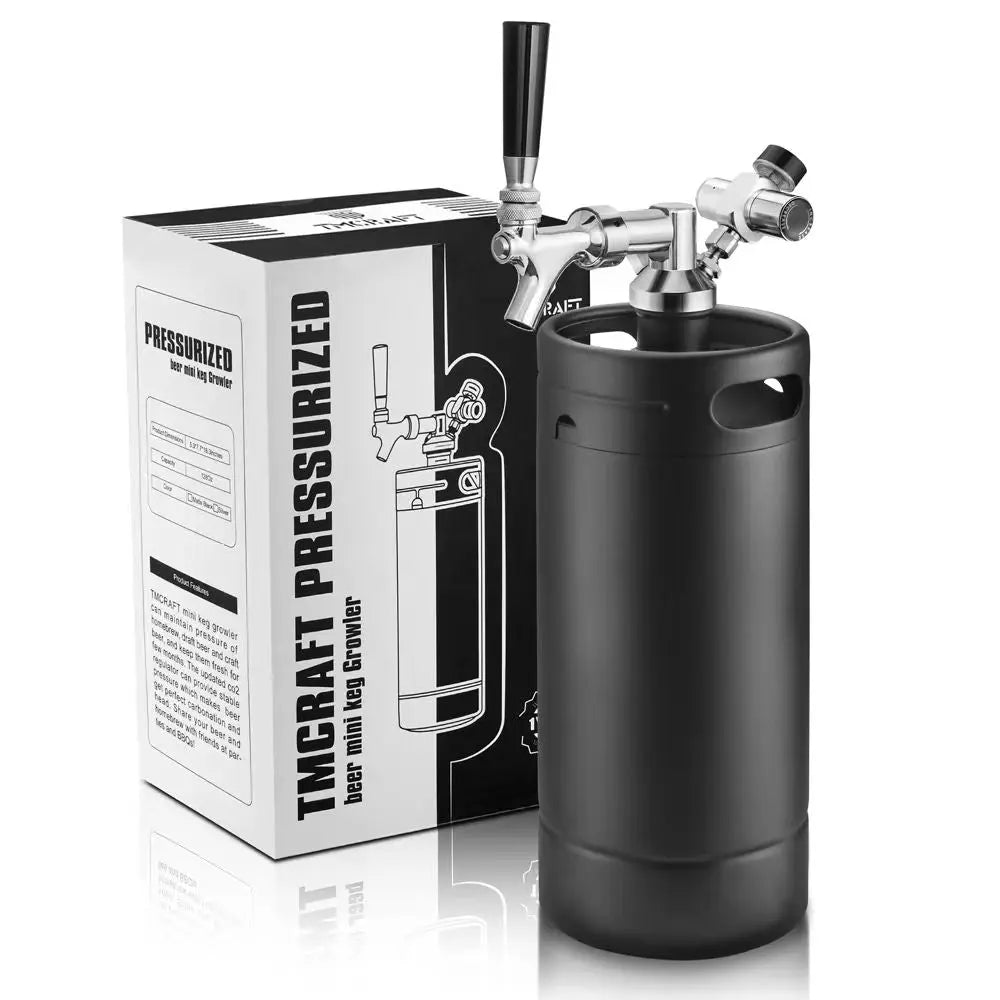Ball Lock Keg Hacks: Tips and Tricks to Get the Most Out of Your Kegging System
 Targets: Ball Lock Keg, Kegging System, CO₂ System, Homebrewing Equipment, TMCRAFT Ball Lock Kegs
Targets: Ball Lock Keg, Kegging System, CO₂ System, Homebrewing Equipment, TMCRAFT Ball Lock Kegs
Dialed-in draft beer isn’t luck—it’s small, smart habits stacked together. Whether you’re pouring at home or packing a travel rig, these ball lock keg hacks will help you carbonate faster, pour cleaner, and keep flavor locked in from first pint to last. All tips apply to standard homebrewing kegging systems and pair perfectly with TMCRAFT Ball Lock Kegs.
1) Eliminate Oxygen, Protect Flavor
Goal: Bright hops, stable malt, longer freshness.
- Closed Transfers: Push beer from fermenter to keg with CO₂ pressure (2–5 PSI). Never open-pour.
- CO₂ Purge & Fill: Before transferring, fill the keg with CO₂ (15–30 sec), vent, repeat 3×.
- Pre-Charge Dip Tube: Briefly crack the gas while the liquid post is connected to flush the tube.
- Hop Keepers: If dry hopping in the keg, use a weighted stainless hop tube to prevent clogging the dip tube.
Quick win: After filling, hit the keg with 20–30 PSI for 5–10 seconds, vent, then set to your carb pressure. This seats the lid and purges headspace O₂.
2) Carbonation—Fast When You Need It, Perfect When You Don’t
Set & Forget (Most Consistent):
- Chill beer to 36–40°F (2–4°C)
- Set regulator to 10–12 PSI for most ales/lagers
- Wait 3–7 days
Burst Carb (When You’re in a Hurry):
- Chill fully
- Set 25–30 PSI for 12–24 hours
- Drop to 10–12 PSI for serving
- If overcarbed, vent and let it settle cold for a few hours, then resume at serving pressure.
Style targets (vol CO₂ @ 38°F):
- English Ales: 1.5–1.8 → ~6–8 PSI
- American Ales/Lagers: 2.3–2.5 → ~10–12 PSI
- Wheat/Belgian: 2.6–3.0 → ~12–16 PSI
3) Line Balance = Perfect Pour
Keep everything cold—keg, lines, and faucet.
- Beer line: 3/16" ID at 8–10 ft is a reliable starting point for 10–12 PSI.
-
Foam fixes:
- Too foamy → lengthen line or lower PSI 1–2 clicks.
- Flat/sputtering → raise PSI slightly or check for warm lines.
- Clean lines every 2–4 weeks. Protein film = foam factory.
4) Hardware Tweaks That Pay Off
- Smooth Pours: Upgrade to a forward-sealing faucet; fewer drips, less sticking.
- Pop the Posts: Keep spare poppets and post O-rings; swap at first sign of leaks.
- Lube Smart: Food-grade keg lube on lid and post O-rings reduces micro-leaks.
- Short Dip Tube for Hazy Beers: Trim ¼" off a spare liquid dip tube to reduce sediment pickup (label that keg!).
- Gas Quick-Disconnect Colors: Color-code gas vs liquid QDs to prevent mix-ups mid-party.
5) CO₂ System Savvy
- Two-Stage Regulator: More stable pressure, especially during burst carb.
- Splitter/Manifold: Run two pressures: one for carbing, one for serving.
- Check for Leaks: Spray soapy water on every joint. Bubbles = leaks = empty tank.
- Protect the Reg: Don’t lay cylinders on their side; keep away from heat; secure the tank.
Travel hack: Use a mini regulator + CO₂ cartridges for picnics/tailgates, then reconnect to your main tank at home.
6) Cold Crash & Clearer Pours
- Cold crash the fermenter 24–48 hours before transfer to drop yeast and hop matter.
- Floating Dip Tube (optional): Pulls beer from the top for bright pours immediately.
- First-Ounce Dump: Vent pressure, crack the PRV, and draw an ounce to remove trub that settled into the tube.
7) Cleaning That Doesn’t Feel Like Chores
- Post-Kick Routine (5 min):
-
- Warm rinse
- Circulate cleaner through liquid line and faucet
- Rinse thoroughly
- Sanitize, then air dry
- Quarterly Deep Clean: Fully disassemble posts, poppets, dip tube. Soak, brush, and replace tired O-rings.
Pro tip: Store kegs with the lid off to prevent stale moisture smells.
8) Foam & Off-Flavor Triage (Cheat Sheet)
- Foam Storm: Warm beer or lines, too much PSI, dirty faucet/line, short lines.
- Flat Beer: Low PSI, warm beer (poor absorption), leaky lid/post O-rings.
- Sour/Buttery/Metallic: Inadequate sanitation, infected lines, residual cleaner, or new-metal residue—deep clean and rinse.
- Won’t Hold Pressure: PRV debris, lid mis-seated, post O-ring cut, poppet damaged, regulator or manifold leak.
9) Beyond Beer—Get More from Your Kegging System
- Soda/Seltzer on Tap: Carb water at 25–30 PSI for 24–48 hrs, serve at 12–14 PSI.
- Cocktails on Tap: Fine-filter, lower carbonation (6–8 PSI) to preserve texture.
- Nitro Stout/Coffee (with stout faucet): Carb low (8–10 PSI), then push with beer gas (75/25 N₂/CO₂).
Why TMCRAFT Ball Lock Kegs Make Hacking Easy
TMCRAFT Ball Lock Kegs are built from 304 stainless with precision-machined posts and reliable PRVs—so your tweaks actually hold pressure and your homebrewing equipment lasts longer.
What brewers love:
- Tight tolerances = fewer leaks, cleaner closed transfers
- Smooth posts/poppets = easy disconnects, less wear
- Durable interiors = flavor-neutral beer batch after batch
Quick Setup Checklist (Print This)
Keg fully cleaned & sanitized
CO₂ purge (3×) before transfer
Closed transfer at 2–5 PSI
Seat lid at 20–30 PSI, then set carb pressure
Lines 8–10 ft, 3/16" ID; everything cold
Spare O-rings, poppets, and keg lube on hand
The Pour-fect Bottom Line
Great draft beer is a system: oxygen control, pressure balance, cold temps, and clean hardware. Master these hacks and your kegging system will pour like a pro every time. Want gear that keeps up? Equip your setup with TMCRAFT Ball Lock Kegs and focus on what matters—brewing the next amazing batch.

